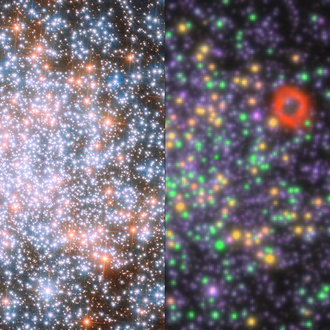Discovery of a Planetary Nebula in a young Star Cluster

Left: A region of the young star cluster NGC 1866 imaged by the Hubble Space Telescope. Right: The same region of the sky in a false-color image from the MUSE instrument with the newly discovered Planetary Nebula as a red ring.
Credit: ESA/Hubble & NASA (left); Bond et al. 2025 (right)An international team of astronomers including scientists from the Leibniz Institute for Astrophysics Potsdam (AIP) unexpectedly discovered a faint Planetary Nebula in the young star cluster NGC 1866 in the Large Magellanic Cloud.
In the course of a spectroscopic study of stars in the young cluster NGC 1866 in the Large Magellanic Cloud (LMC), using the MUSE integral field spectrograph at the ESO Very Large Telescope, an unexpected and enigmatic discovery was made: the ionized shell of a planetary nebula. The object is named “Ka LMC 1” after the discoverer Sebastian Kamann, who had developed the technique of crowded field 3D spectroscopy during his PhD project at AIP in 2013, which is the unique technique needed to take spectra of cluster stars like in NGC 1866. In a follow-up study, an international group of researchers, involving three astronomers from AIP, investigated the nature of this object with images from the Hubble Space Telescope (HST), and a detailed image and spectral analysis of the MUSE data cube.
Planetary Nebulae represent a late stage of stellar evolution, when a star has consumed its fuel (hydrogen) for nucleosynthesis, expands as a red giant with shell burning processes, and finally sheds a large fraction of its mass into a huge detached expanding shell, before the remaining core contracts, becomes very hot, and finally dims to become a white dwarf. When the core becomes hotter than 35,000 degrees, it ionizes the shell, which becomes visible in emission lines at selected wavelengths.

The figure shows an image of the globular cluster NGC 1866, superimposed with a false color image from the MUSE data cube, where the ionized shell of the Planetary Nebula Ka LMC 1 is seen as a red ring, The greyscale images to the right illustrate the different size of the ionized shells of singly ionized nitrogen [N II] and doubly ionized oxygen [O III]. The magnified HST image near the center of the ring (cross) reveals the presence of a pale blue star – most probably the hot central star of the Planetary Nebula.
Credit: AIP/M. M. Roth, background: ESA/Hubble & NASASuperimposed on the background of the HST image, the figure shows a reconstructed false color image from the MUSE data cube, where the ionized shell of Ka LMC 1 is seen as a red ring, The greyscale images to the right illustrate the different size of the ionized shells of singly ionized nitrogen [N II] and doubly ionized oxygen [O III]. The faint emission – not detected by HST – can only be made visible thanks to the spectral resolution of the MUSE instrument and modern digital image processing, which makes it possible to remove disturbing cluster stars. The magnified HST image near the center of the ring (cross), however, reveals the presence of a pale blue star: in all likelihood the hot central star of the Planetary Nebula.
Prof. Martin Roth, one of the collaborators of the study, notes: “Ka LMC 1 really is a puzzle: for the young cluster age of 200 million years, we require the progenitor star to be quite massive. But such a star would evolve very rapidly towards the white dwarf cooling track. We have had trouble to reconcile the age of the expanding shell of the Planetary Nebula with theoretical evolutionary tracks for the central star.“
The object clearly deserves more detailed observations to unravel its nature. It is one of the rare occasions where stellar evolution can be caught in the act: typically, the time scales are millions, if not billions of years. The massive central star evolution, however, is a matter of only thousands of years – and it can be calibrated against the expansion timeline of the nebula.
Publications
- Bond, H.E., Bastian, N., Bellini, A., Kamann, S., Libralato, M., Niederhofer, F., Roth, M.M., and Soemitro, A.A. 2025, PASP 137, 114202, Published 2025 November 7
doi:10.1088/1538-3873/ae1664, https://iopscience.iop.org/article/10.1088/1538-3873/ae1664 - Kamann, S., Bastian, N., Niederhofer, F., Bellini, A., Cabrera-Ziri, I., Dreizler, S., Göttgens, F., et al., 2025, MNRAS, 542, 2768.
doi:10.1093/mnras/staf1371, https://academic.oup.com/mnras/article/542/4/2768/8245867 - Kamann, S., Wisotzki, L., Roth, M.M., 2013, A&A, 549, A71.
doi:10.1051/0004-6361/201220476, https://www.aanda.org/articles/aa/full_html/2013/01/aa20476-12/aa20476-12.html
Images
Left: A region of the young star cluster NGC 1866 imaged by the Hubble Space Telescope. Right: The same region of the sky in a false-color image from the MUSE instrument with the newly discovered Planetary Nebula as a red ring.
Big screen size [1000 x 1003, 1.9 MB]
Original size [1570 x 1576, 4.1 MB]
The figure shows an image of the globular cluster NGC 1866, superimposed with a false color image from the MUSE data cube, where the ionized shell of the Planetary Nebula Ka LMC 1 is seen as a red ring, The greyscale images to the right illustrate the different size of the ionized shells of singly ionized nitrogen [N II] and doubly ionized oxygen [O III]. The magnified HST image near the center of the ring (cross) reveals the presence of a pale blue star – most probably the hot central star of the Planetary Nebula.
Big screen size [1000 x 625, 1.1 MB]
Original size [2505 x 1567, 5.3 MB]




